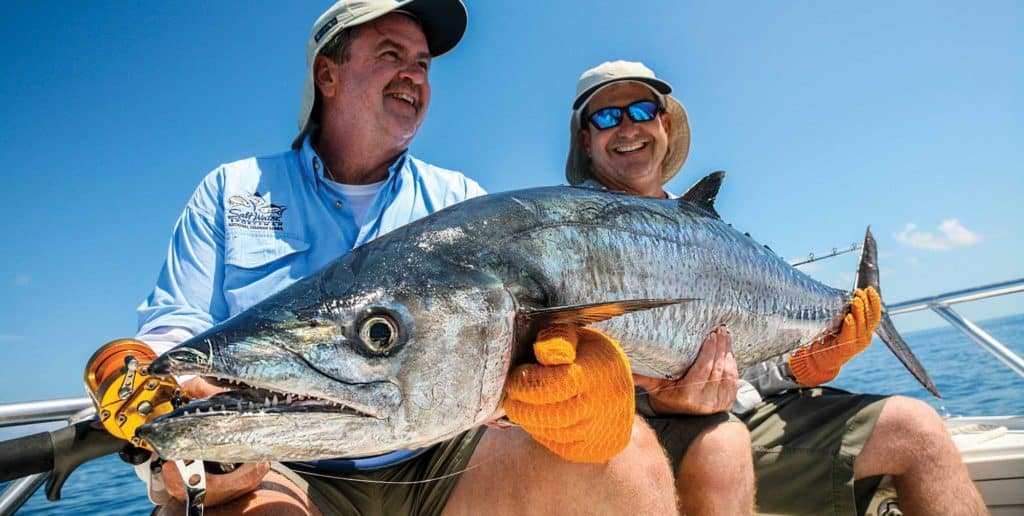
Twenty-pound braid raced from the small Penn 4500 spinner. I held the rod high, loosened the drag and hoped the fish would stop.
Fortunately, it ceased running after emptying three-quarters of the spool. Now my fear was it would swim beyond the ledge and part the line on the coral. Remarkably, that didn’t materialize either. With the big king reasonably under control, our fear shifted to the sharks. And through it all, I was hoping the 30-pound titanium leader and small hook would hold.
We were anchored off Bimini, and the yellowtails had shut down due to a wolf pack of sharks moving in. However, some cero mackerel appeared, and I began drifting baits back for them. And that’s when I hooked the big king. Over the years, we’ve bested kings as large as 66 pounds aboard my MARC VI, with several in the 50-pound class, but I never saw this one coming, a 55-pounder under seriously challenging conditions.
Miraculously, in lieu of these obstacles, we landed the big king.
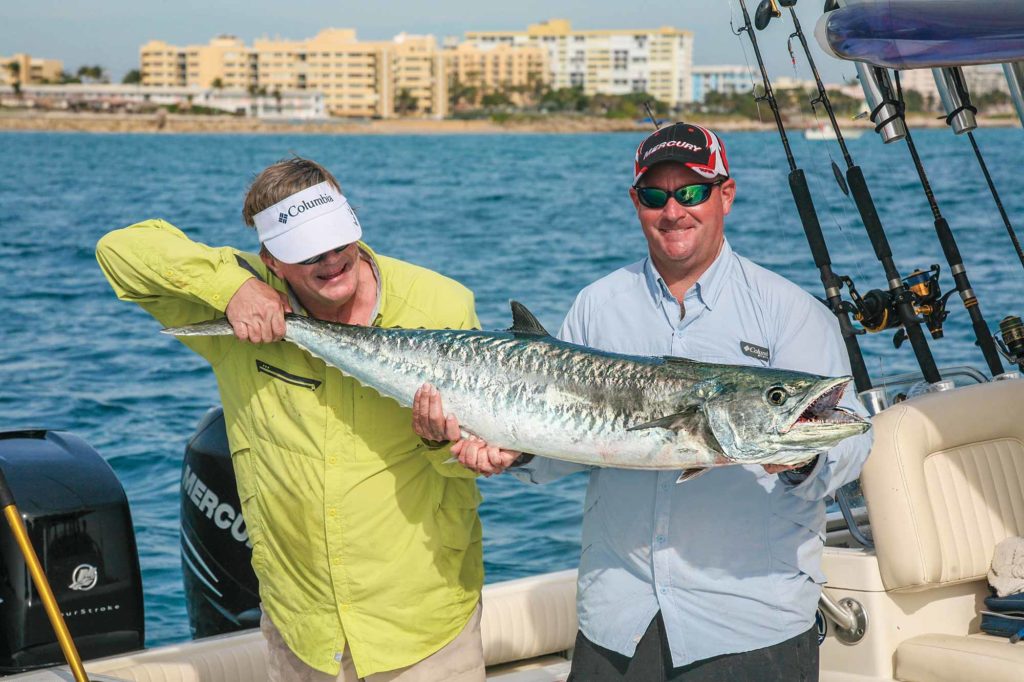
Nonconformists Kings exceeding 25 pounds are impressive predators and extremely challenging on 20-pound-class and lighter tackle. And should you score, they’re quite delicious when smoked and even parlayed into a dip. School kings are fun too, but I’ll take one big smoker over a bunch of snakes.
Unlike school kings, the smokers migrate to the beat of a different drummer. Dr. Bob Shipp, Professor Emeritus of Marine Sciences at the University of South Alabama, reports that the king mackerel migration in the northern Gulf used to parallel the cobia run, with schools of 10- to 20-pound-class kings arriving in March or April.
“That certainly has changed over the last 20 to 30 years,” says Shipp. “It was water temperature which drove the migrations of the larger kings, as it still does for the smaller ones. But now, for the big kings, it’s all about forage. They’re not as migratory in our region anymore. Instead, they hold at the rigs, wrecks, structures and artificial reefs where the forage is. Structures holding bait year-round will also hold big kings year-round.”
Off Alabama, a 1,200-square-mile permitted area holds abundant artificial reefs, cement pyramids and other environmentally compatible materials. And nearly every one of these reefs holds bait and big king mackerel. Find the structures holding masses of bait and there should be some big kings around them, says Shipp.
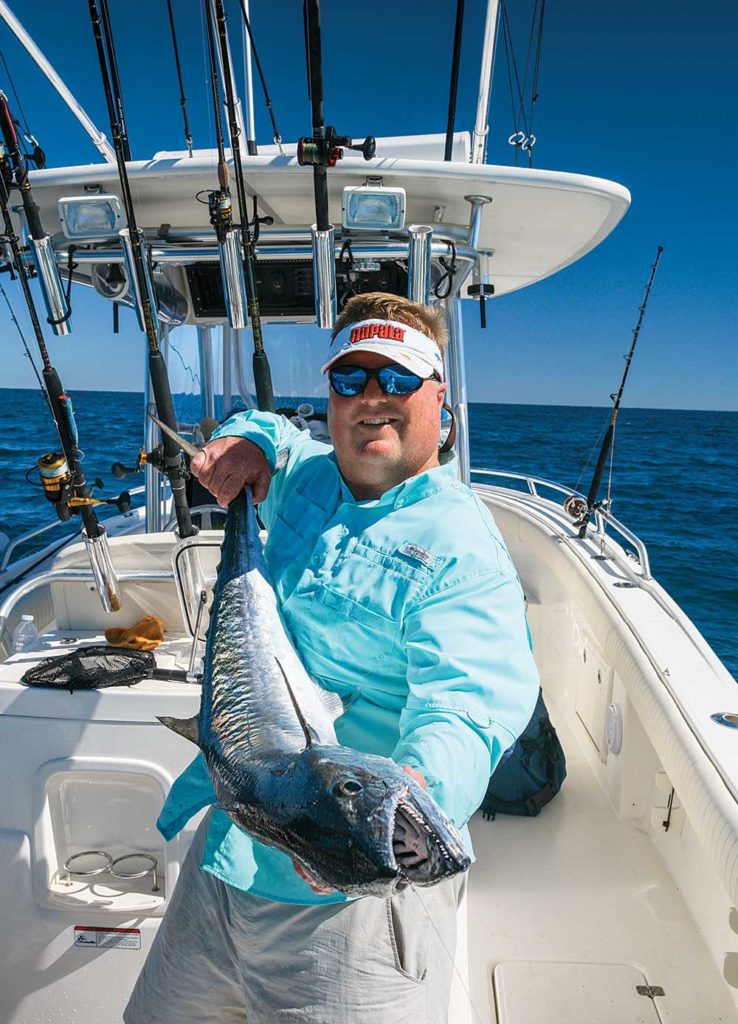
Florida Keys Chime In Key West Capt. Mark Schmidt echoes Shipp’s sentiments for Gulf-side kings.
“In the Gulf, big kings gather around structure as small as troughs and rock piles,” says Schmidt. “It’s all about the forage. Yellowtails are a huge part of their diet. Big kings will be on any troughs, wrecks, shoals, rock piles or ledges that hold ’tails on both the Gulf and Atlantic sides.”
Gulf fish show in numbers in late January or February, whereas the Atlantic stocks show up in November. “It depends on our cold fronts,” says Schmidt. “A couple of strong ones back-to-back, or lack thereof, and the fish may move in early or lag behind longer than normal.”
March is a solid month for big kings off Key West, though some are around every month of the year. A lot of the old-timers still catch big kings right out front of Key West. They refuse to burn gas and run any distances. But for those who aren’t afraid to travel, the largest concentrations of big kings still migrate well west of Key West, from the Marquesas to the Dry Tortugas. Credit that to vast amounts of bait, structure and lighter fishing pressure.
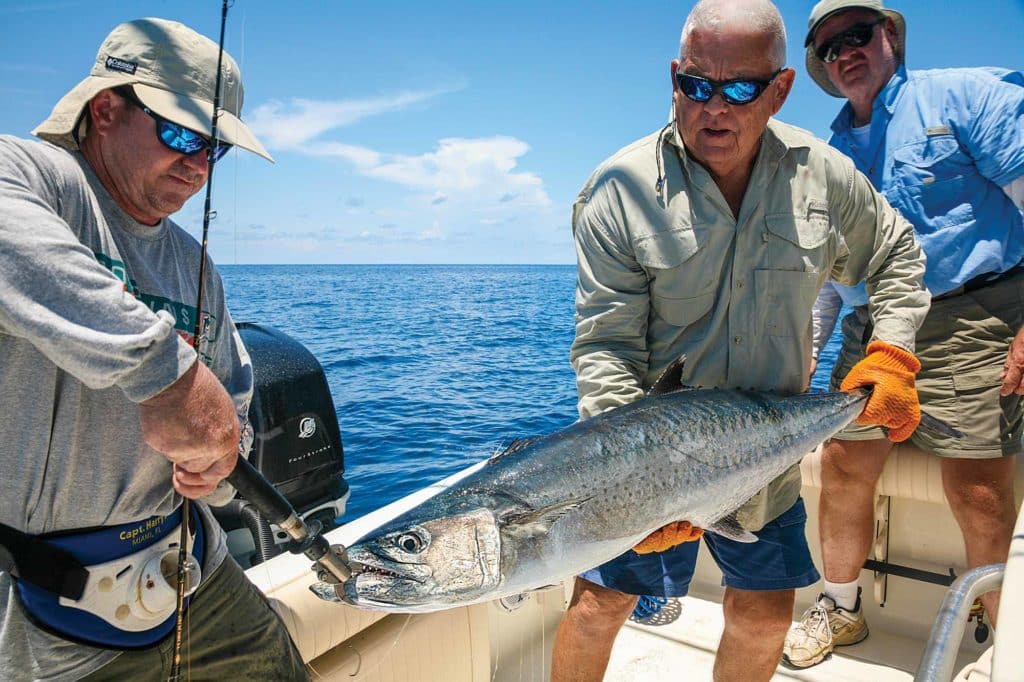
Kings of the Bahamas Some of the largest king mackerel thrive in Bahamian waters. It’s believed these big kings don’t migrate but are rather territorial along stretches of reefs where they find a constant supply of yellowtails, blue runners, jacks, tinker mackerel, chubs and cero mackerel as food sources. Compared to their longer and slimmer U.S. cousins, big Bahamian kings are often shorter and stockier.
Notable monster-king haunts include the Atlantic-side reefs near Bimini, down through the Riding Rocks, and up into Northwest Providence Channel from North Rock to the Gingerbreads. However, wherever thriving reefs exist, big kings reside, particularly in the far, less-pressured reaches of the Bahamas.
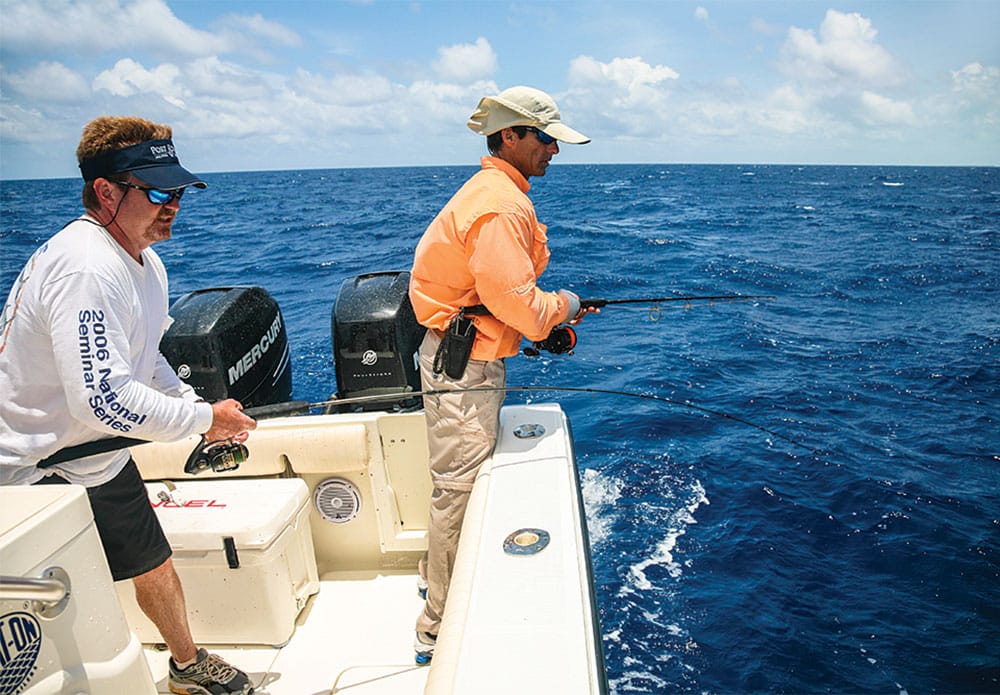
East Coast Take Palm Beach Capt. Greg Bogdan says his best kingfishing runs start late March and last through June. “They’re migrating with all the bait,” says Bogdan. “The steep drop from around 110 to 140 feet of water between Lost Tree Village and Juno is alive with bait. I’ve done dives along this drop; there are loads of speedos, bonito, runners and such — prime forage for big kings. I’ll fish along its outer edge and where there’s a current washing over it.
“Wrecks are excellent too, especially during the winter. Big kings hang on them for the bait. And within 3 miles of Palm Beach Inlet, there are 11 wrecks, all productive. They’re close to the inlet and that 110- to 140-foot drop, all bait-rich zones.”
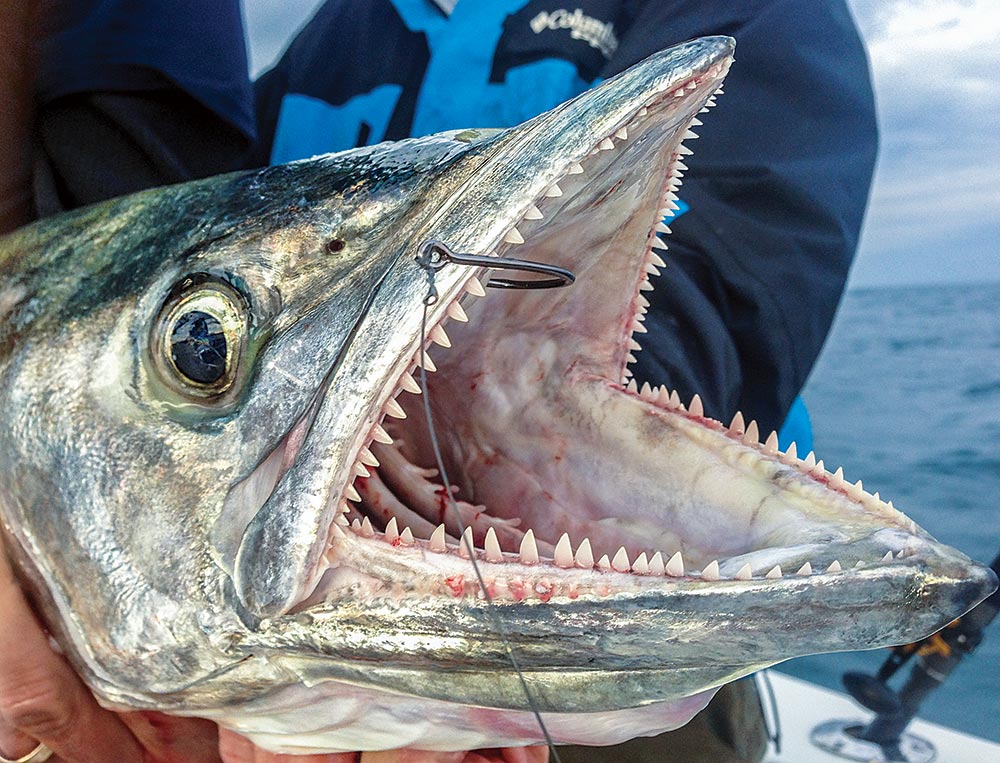
Monster Sammies “It’s a cliché, but big baits catch big fish, and that certainly goes for big kings,” says Shipp. “Off Alabama, the rigs have plenty of 1½- and 2-pound hardtails (blue runners); they’re the best big-king baits up here.”
Schmidt also favors large blue runners and legal-size yellowtails for big kings. Off the Atlantic and Gulf sides of the Keys, and Florida’s southern and central west coasts, some of the largest kings fall to live Spanish and cero mackerel. Bogdan prefers live speedos and bullet bonito when gunning for the big ones.
Fishing techniques are regional. Yet an across-the-board knockout tactic on big kings is to slow-troll a pair of Spanish or cero mackerel around those schools, or bump-troll them out over patch reefs and bottom structure. Use downriggers in deeper waters.
A potent tactic in South Florida, the Florida Keys and the Bahamas is to first anchor and chum for yellowtails. After about an hour of ’tailing, free-line a Spanish or cero mackerel or a legal-size yellowtail well back in the slick on a balloon float. Place the rod in a holder and resume yellowtailing. Sooner or later, that live-bait rod will scream. Big kings are also suckers for baits splashing underneath a kite; keep this in mind when live-baiting at drift or anchor.
Tuned Strategy Light single-strand wire leaders and diminutive treble hooks are believed to draw more strikes because they’re less noticeable than stouter rigs. However, very light drag settings are required to keep these hooks from pulling or straightening. In short, a big king is forced to run until it exhausts itself — not a good scenario for releasing unwanted fish.
I continue to enjoy success with a dual circle-hook rig fabricated with 50-pound titanium or 60-pound single-strand wire and 4/0- to 6/0-size hooks. Embed the lead hook in front of the bait’s dorsal, with the trailing hook left dangling. With a large bait such as a mackerel, embed the stinger circle lightly in its mid or aft dorsal-fin area.
Read Next: How-To Catch Smoker Kings Like the Pros
Once floated into position on a balloon, the rod goes into a holder. When a big king hits, the rod bends and sets either the lead or trailing circle hook. If the rod straightens back up after the strike (a missed hook-set), immediately free-spool; providing the remaining bait portion floats back naturally, the king should circle back for it. When the line speeds up, engage the drag, wind to set the hook, and enjoy the fight.
Once a circle hook sets, it’s not coming out. Furthermore, the hooks are large enough to withstand pressure from a 20-pound outfit. Should we choose to release the fish, it won’t be hooked deeply with a circle hook, and it should have enough energy to swim away. The single circles are also much safer to the person releasing the fish.









